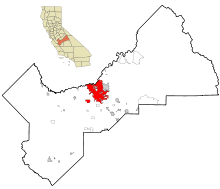Fresno, California
![]()
The title of this article is ambiguous. For other meanings, see Fresno (disambiguation).
![]()
This article or section is still missing the following important information:
History is missing completely, maybe a little en:Timeline of Fresno, California will help.
Help Wikipedia by researching and adding them.
Fresno is a city in Fresno County in the U.S. state of California, at the foot of the Sierra Nevada. The urban area has a size of 271.4 km2. With a population of approximately 522,000 (2016 estimate, U.S. Census Bureau), Fresno ranks fifth on the list of California's largest cities. Fresno is located in the middle of the San Joaquin Valley, about 320 kilometres (200 mi) north of Los Angeles and 270 kilometres (370 mi) south of California's capital, Sacramento. In Spanish, Fresno means ash tree, the leaf of which is depicted in the center of the flag. The city is the seat of California State University, Fresno and the Roman Catholic Diocese of Fresno.

Location Fresnos in Fresno County
Population development
Like many cities in California, Fresno is growing rapidly. Its population more than quintupled between 1950 and 2010. From 1980 to 2010, it more than doubled:
| Year | Inhabitants¹ |
| 1950 | 91.669 |
| 1960 | 133.929 |
| 1970 | 166.655 |
| 1980 | 217.491 |
| 1990 | 355.202 |
| 2000 | 429.583 |
| 2010 | 496.112 |
| 2016 | 522.053 |
¹ 1950-2010: Census results; 2016: US Census Bureau estimate.
History
The original inhabitants of the San Joaquin Valley area were the Yokuts. They traded with other California tribes. Fresno County was formed in 1856 after the California Gold Rush. It was named for the ash trees (Spanish: Fresno) that stood on the banks of the San Joaquin River.
Millerton, near Fort Miller, became the county seat. Other early settlements of the county were Firebaugh's Ferry, Scottsburg, and Elkhorn Springs.
On December 24, 1867, the San Joaquin River overflowed its banks and flooded Millerton. Some residents rebuilt everything, others moved away.
The actual founding of Fresno is credited with the establishment of the Central Pacific Railroad's depot at Easterby's in 1872. They established the first Southern Pacific lines at that time. A business center quickly formed around the railroad station, and Millerton residents began moving near it, partly to escape further flooding. Just two years after the railroad station was built, the township seat was moved there. This was followed in 1885 by the incorporation of the independent city of Fresno. The old parishes of Millerton were flooded with the construction of the Friant Dam and today lie under Millerton Lake.
The central location in the Valley influenced further development. As early as 1910, the California state government decided to build a central road axis, parts of which were designated California State Route 99 in 1926. At that time, ideas for the construction of a transverse axis connecting the coast with Yosemite National Park also emerged. The construction company was formed in 1930, and in 1934 the route was designated California State Route 41. The third route included a connection to the Kings River, which was laid out as early as 1905 - this was extended by 1933 and designated California State Route 180 in 1935. Today, the three state routes encircle the business center of Fresno as a freeway ring - the intersection-free extension with three interchanges was completed by 1980.
The Fresno Municipal Sanitary Landfill was the first modern landfill in the United States. It opened in 1937 and was closed in 1987.
In September 1958, Bank of America introduced a new product called BankAmericard in Fresno. BankAmericard became the first successful credit card, which was spun off to Visa Inc. in 1970.
Search within the encyclopedia